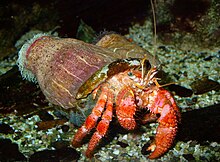Sagartia parasitica
| Calliactis parasitica | |
|---|---|
 |
|
| Calliactis parasitica with the hermit crab Dardanus calidus | |
| Scientific classification | |
| Kingdom: | Animalia |
| Phylum: | Cnidaria |
| Class: | Anthozoa |
| Order: | Actiniaria |
| Family: | Hormathiidae |
| Genus: | Calliactis |
| Species: | C. parasitica |
| Binomial name | |
|
Calliactis parasitica (Couch, 1844) |
|
| Synonyms | |
|
|
| External identifiers for Calliactis parasitica | |
|---|---|
| Encyclopedia of Life | 421294 |
| ITIS | 52655 |
| NCBI | 6114 |
| WoRMS | 100946 |
| Also found in: SeaLifeBase, MarLIN, NMNI | |
Calliactis parasitica is a species of sea anemone associated with hermit crabs. It lives in the eastern Atlantic Ocean and Mediterranean Sea at depths between the intertidal zone and 60 m (200 ft). It is up to 10 cm × 8 cm (3.9 in × 3.1 in) in size, with up to 700 tentacles, and is very variable in colour. The relationship between C. parasitica and the hermit crab is mutualistic: the sea anemone protects the hermit crab with its stings, and benefits from the food thrown up by the hermit crab's movements.
Calliactis parasitica is up to 100 millimetres (3.9 in) tall, and 80 mm (3.1 in) wide, with the base of the column being slightly wider. The surface of the column is rough and leathery with a grainy appearance, but has no tubercles and is not divided into sections. It is variable in colouring, but is usually cream or buff in colour, with blotches and streaks of reddish or greyish brown, which tend to form vertical stripes.
The basal disc is concave, and able to stick firmly to the substrate. Above this lies the limbus (the junction between the basal disc and the column), and just above that are the relatively prominent cinclides (specialised pores), each on a small mound. These readily emit threadlike (stings) when the animal is disturbed. At the top of the column are up to 700 slender tentacles of moderate length. They are translucent, and yellowish to orange in colour, with longitudinal lines of reddish brown.
Calliactis parasitica is found in the north-eastern Atlantic Ocean and the Mediterranean Sea. Its Atlantic range extends from south-western Europe as far north as the west coasts of Wales and Ireland, and the English Channel. Although this species has been recorded from the southern North Sea, those records are considered dubious. The depth distribution of C. parasitica ranges from a depth of 60 metres (200 ft) to the sublittoral zone; it is rarely found in the littoral zone.
...
Wikipedia
